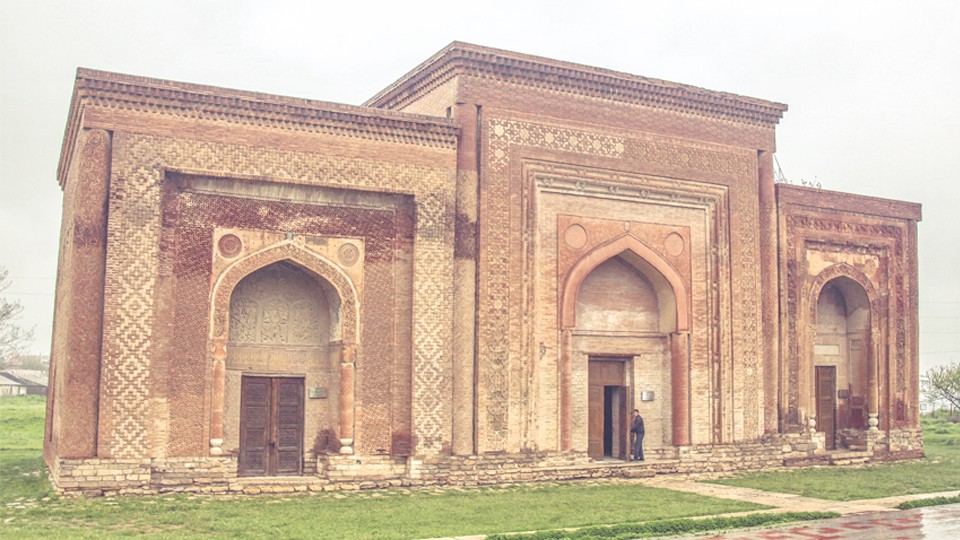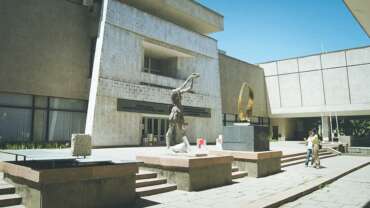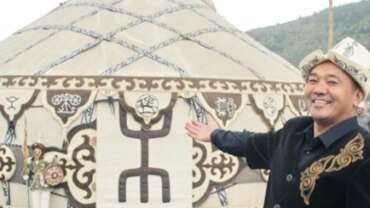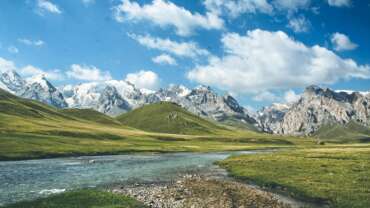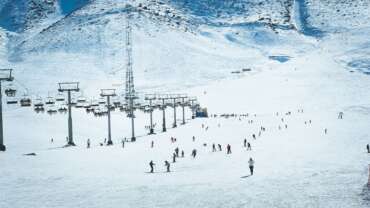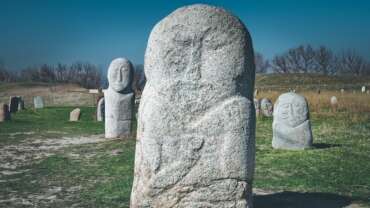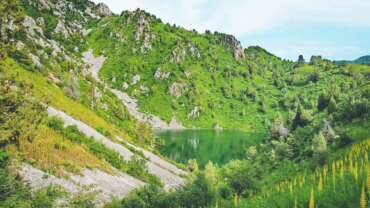Historical & Cultural Tourism in Kyrgyzstan
UZGEN (ÖZGÖN) MINARET
The Uzgen minaret is located in the town of Uzgen, which became the capital of the Karakhanid Khanate in the 12th century. The minaret is part of The Uzgen Historical and Architectural Complex dating back to 11th-12th centuries. Due to strong earthquakes, the top of the minaret has been destroyed and now sits at a height of 27.5 meters, however the structure of the minaret suggests that it originally stood about 45 meters tall. The walls of the building are made of fired brick and are decorated with patterns. The purpose of the minaret was to call the people to commit the namaz (obligatory prayer of muslims) as well as serve as a watchtower.
ÖRNÖK PETROGLYPHS
The outskirts of the Örnök village, in the Issyk-Kul province, host priceless historical monuments, such as petroglyphs and burial mounds. More than 2000 stone blocks have engraved images of wild and domestic animals and life-scenes (such as hunting, war, rituals, etc.) of ancient inhabitants of these lands, representing different time periods – Skythian, Usun, and Turkic.
BURANA TOWER
Being once a minaret of a mosque, Burana Tower is located near Tokmok in the territory of Balasagun, which was a medieval capital (9th – 14th centuries) of Karakhanid Khanate and home to famous medieval poet Yusuf Balasaguni, author of the poem Kudatgu Bilig (Beneficial Knowledge). The tower was built in the first half of the 11th century. With time, the mosque got completely destroyed, and the minaret was partially ruined by an earthquake in the 15th century. Today, the tower stands at about 25 meters, although it was originally 45 meters tall. An open-air archaeological and architectural museum was created at the basis of the legendary Balasagun.
ALA-TOO SQUARE
The Ala-Too Square is one of the main attractions of the country and a favorite place for all city dwellers. Construction of the entire complex was completed in the 1970’s. This spacious area is a venue for celebrations, festivals, and rallies. Each and every of the monuments erected in memory of the Kyrgyz people’s heroes (Manas Magnanimous, the great writer Chyngyz Aitmatov, wise and brave Kurmandjan Datka and the heroes who fell in Aksy, and April events) decorate the square. A 45-meter flagpole flaunts in the heart of the square. The Government House, State Historical Museum, Oak Park, Monument of Friendship of Peoples, Open Air Sculptures Museum, and many other cultural and recreational facilities are located on the perimeter of the square.
GAPAR AITIEV ARTS MUSEUM
The museum was founded on January 1, 1935. Seventy-two works of Russian artists received from the State Tretyakov Gallery and the Hermitage make up the basis of the museum. The museum includes works by painters and sculptors of both the Soviet Era and modern Kyrgyzstan, as well as items of traditional Kyrgyz decorative and applied arts – which allow one to see and understand the development stages of the Kyrgyz culture and art – and that of the formation of national school of professional fine arts. Among the artists of famous works presented in the museum, it is worth mentioning G. Aitiev, S. Chuikov, S. Akylbekov, L. Ilyina, T. Sadykov, and T. Herzen. Today, there are about 18,000 artworks in the museum, and it is regularly updated with the works of Kyrgyz artists.
DUNGAN MOSQUE
The Dungan Mosque was built in 1910-1912. This particular style of architecture was created by the best masters, headed by architect Zhou Si, who Haji Ibrahim specially invited from Beijing. The local people also took part in the construction of the mosque. This one-storey wooden building was made without a single nail. The corners of the roof were decorated with dragon figurines; the walls with images of plants and mythological animals which, according to popular belief, bring abundance and ward off evil spirits, respectively.
RUH ORDO CULTURAL CENTER
The Cultural Center, named after famous Kyrgyz writer Chyngyz Aitmatov, was founded in 2002 in Cholpon Ata, right on the shore of Issyk Kul Lake in the open air. Ruh Ordo combines elements of various cultures and religions. Sculptures and portraits of famous people who left their mark in the history of mankind can be found here. One may also visit the Buddhist, Catholic, Orthodox, Muslim and Jewish churches that sit next to each other, symbolizing the unity of faith of all people on Earth. Ruh Ordo, which means ‘spiritual center’ in Kyrgyz, is a special place where the atmosphere of peace prevails, which allows one to move away from the daily hustle and bustle and make a short trip into the world of beauty, into the spiritual world.
MANJYLY ATA VALLEY
The Manjyly-Ata Valley, also called the Valley of Sacred Springs, is located on the southern shore of Issyk Kul Lake between the Kaji-Sai and Tong villages. The waters in the springs, which are located among numerous clay hills, are considered sacred and curative, each having a different taste. According to legend, the area is the mazar (burial place) of a once famous old healer whose name was Manjyly. After his death, people kept visiting his mazar hoping to find cures for their ailments, thus making it an object of pilgrimage.
GUMBEZ OF MANAS
The Gumbez (Mausoleum) of Manas, a medieval architectural monument, is located in Kenkol valley, 22 km north-east of Talas. Although well known among people and in scientific literature as the Mausoleum of Manas, the inscription on the wall reads that the tomb belongs to the daughter of one of the rulers of the Chagatai Khanate. There is a famous legend saying that Kanykei, Manas’s wife, ordered masters from Bukhara and Samarkand to build this monument in memory of her deceased husband and that the girl’s name on the tomb was inscribed specially in order to distract the attention of the enemies. The walls of this building constructed of brick are decorated with Kyrgyz patterns and Arabic inscriptions. Today, it is surrounded by an architectural complex called Manas Ordo.
MAUSOLEUM OF SHAH FAZIL
The Mausoleum of Shah Fazil is a part of the Shah Fazil Historical and Architectural Complex. The complex is located in the Gulistan village of Ala Buka district. The mausoleum is the burial place of Mahmud ibn Nasir (nicknamed Shah Fazil, fair shah), who came from the Kara-Khanid dynasty that ruled in the 10th-12th centuries. The height of this pyramidal structure is 15.5 meters. The structure consists of a step drum and tall dome resting on it. The interior of the building is decorated with ganch-stucco carvings of bright colors.
SAIMALUU TASH STATE NATURAL PARK
Saimaluu Tash State Natural Park is situated in the Toguz Toro district of the Jalal Abad province, along the Kugart River. It sits on a total area of 32050 hectares. 16 species of mammals, 45 species of birds, and 1500 species of plants are registered in the park. Saimaluu Tash means ‘patterned stone’ in Kyrgyz. Rock carvings are the main cultural and historical value of the park. The area has the largest accumulation of petroglyphs (about 90,000 stones) in Central Asia.
HOLY TRINITY ORTHODOX CHURCH
The Holy Trinity Orthodox Church is located in the center of the city of Karakol. It was built in 1894-1895 on the site of an older church, which was destroyed by an earthquake. The facade of this four-column church is decorated with carvings, a bell tower at the top, and a gilded dome on the roof, characterizing a traditional Orthodox church. The church is home to the miraculous icon of Our Lady of Tikhvin.
TASH RABAT CARAVANSERAI
This well preserved historical monument is located 110 km from the town of Naryn, in the valley of Kara Koyun, stationed at an altitude of 3200 meters. It was built approximately in the 15th century, and was home to merchants and travelers, and linked the Fergana and Chui valleys to Kashgar.
ATA BEYIT MEMORIAL COMPLEX
The Ata Beyit Memorial Complex is located 30 km from Bishkek in the village of Chong-Tash. The complex was built on the burial site of the bodies of 137 people of 19 nationalities who were executed without any trial during the Stalinist repression. Their bodies were thrown into the brick kiln. There were eminent statesmen and public figures among these people who had laid the foundation of Kyrgyz statehood back in the 1920’s and 1930’s, such as Zhusup Abdrakhmanov, Bayaly Isakeev, Törökul Aitmatov (Chyngyz Aitmatov’s father), Hassan Zheenbaev, Erkinbek Esenamanov, Murad Salikhov, Sultankul Shamurzin, Imanaaly Aidarbekov and Kasym Tynystanov. Interestingly, the location was kept secret, and only in the early 1990’s, based on Bübüra Kydyralieva’s story, did the public learn about the place. Extensive work has been done to identify each of the bodies and the remains of the victims had been properly buried on August 30, 1991.



